I joined the fortunate group of people who can say they own a Tesla Model S in late May of this year. My wife and I did a ton of research on the car and the life of switching to a fully electric car before we made the commitment, but I didn’t realize how much I didn’t know until after we lived with it for the last two months. Since we got it, I’ve fielded many of the same questions so I figured a detailed post would be nice to point to plus it might help someone else who is doing the same research we were doing in March 2015.
At the end of this post I documented our experience on a long road trip we just completed. That’s easily the biggest unknown with the Tesla and one of my biggest questions.
TL;DR
I have zero regrets. As someone who’s always been interested in cars & tech, Tesla has always interested me. However I had no idea how much I’d love the Model S. I’ve had the chance to drive a Lamborghini Gallardo & Ferrari 458, but the Model S is the most fun car I’ve ever driven. The tech in the car is very impressive & I love the environmental aspect to the car… the only downside is the cost.

Tesla Model S
Purchasing
It’s not like buying a car. It’s like going into Best Buy or Apple to buy a new laptop. There are no commissioned sales people or haggling on price. The stores are there just to do a test drive or pickup your car. You order online. If you don’t like the price, remove an option… it’s that simple. You put a deposit down of $2,000 to reserve your car. I had great joy in paying for my car with my PayPal account as their website wouldn’t accept American Express and I wanted the points. I then had to wait two months for the car to be built in Fremont, California and then shipped across the country to my closest Tesla store: Orlando, FL. The entire experience, from ordering to scheduling my delivery to arranging financing to submitting my auto insurance details… 100% of it was done either over email or online through their website. This is how it should be done… it was so incredibly easy!
Charging
Ah… this is easily the source of the most unknown (on my part) and questions (from other folks). Two months ago I didn’t have as much understanding of electricity, but now I do in part because I was interested in it and part because you really should understand it to get the most out of your car. This isn’t to say you need to become an electrical engineer and you can get by just fine, but it does help.
The best way to understand electricity is to think about it as water. The charge something has is like water. The pressure of the water is voltage, also defined as the amount of potential energy between two points in a circuit. For instance, a standard outlet in a US is 110 volts which means that anything that is plugged in can get as much as 110 volts from the wall outlet. Some appliances, like a modern clothes dryer, needs more power, so you have a special outlet that’s rated at 240 volts. Finally, the speed or amount at which the charge gets from one location to another is measured as it’s amperage or amps. An ampere is measured as 6.241*1018 electrons per second.
Looking for more details, explanation on things like resistance, Ohm’s Law and some pretty pictures? Check out the article Voltage, Current, Resistance & Ohm’s Law on one of my favorite sites, SparkFun.
OK, now you have that under your belt, let me explain the different options on how you can charge a Tesla. It comes down to five options, some more common than others. Your car comes with the 20’ mobile charger cable that includes two plug adapters (110V & 240V) and one J1772 adapter you don’t use with the cable (more on that in a moment).
For some perspective below, you can get a Tesla Model S in three different configurations: 70, 85 or 90 kilowatt (the capacity of the battery). I have a 85D. At 100% I can usually get around 260 miles of range, however you generally only charge up to 90% (244 miles of range) as charging to 100% puts the most strain on your battery and takes the longest to charge. So normally you have the car set to only charge up to 90%, but the night before a long road trip, you can bump it up to 100% via controls in the car or via the companion app on your phone.
110 Volts
This is the most common outlet you find in North America. It’s the common 3-prong outlet. This lets you charge anywhere, but it also is the slowest option. A 110V outlet has a low amp rating and because of the low voltage & amps, you’ll find you only get about 3-4 miles of range per hour of charge. You really don’t want to use this unless you have to. For example, here’s what I got when plugged into the rental beach house we had last week:

Tesla 110 Charging Rate
Clearly not a good option every day, but nice when you’re on vacation. You can do the math on charging… for us, we rolled into our rental house around 11:30p on Saturday night with 103 miles estimated range remaining. By Monday night, it was back up to a 90% charge.
240 Volts
This outlet is what most modern clothes dryers in the US use. It’s a 4-prong outlet known as NEMA 15-40. We had one installed in our garage near the right-rear of where the car is when it’s parked as that’s where the charge port is. This is how we, and most people, charge their Model S 95% of the time. On a good outlet, we can pull 240 volts at 40 amps which equates to about 28 miles of range per hour of charge.

Tesla 240 Charging Rate
J1772 Level 2 (wikipedia link)
This is the plug type that all electric vehicles use and what you see on public charging ports like at malls, airports, parking garages, Whole Foods parking lots, Nissan & BMW dealerships, etc. This comes in two flavors: the J1772 Level 1 has a peak voltage of 120 V and 16 amps which isn’t too much better than a typical wall plug. However the J1772 Level 2 has a peak voltage of 240V and anywhere from 32 - 80 amps.
Hard to say what the charge speed is with this. At a Whole Foods parking lot I got about 9 miles / hour of charge while at the Charlotte, NC airport we were closer to 19 miles / hour. Just depends on the quality of each location.
The Tesla mobile connector cable includes an adapter that you can put on the end of a J1772 charging cable that makes it fit with a Model S.
Tesla Supercharger
The supercharger option absolutely rocks for road trips, and it’s really only meant for that. Tesla maintains a network of superchargers around the US, Europe & Asia that help you manage road trips. See my road trip story below for details on our recent use.
These are free to Tesla Model S owners and generate an absurd charging rate! They are capable of 300+ volts at 200+ amps to charge at a rate of over 300 miles / hour! You can get a 50% charge in just 20 minutes or up to 80% in just 40 minutes! The last 20% takes another 35 minutes because… well the Tesla site says it best:
Check out one of our recent experiences compared to the above options:

Tesla Supercharger
The onboard navigation in the car helps you find superchargers along your route & better yet, they are always located near malls or restaurants. While your car charges, it will notify you via the app when it’s almost finished charging so you can head back to continue your trip.
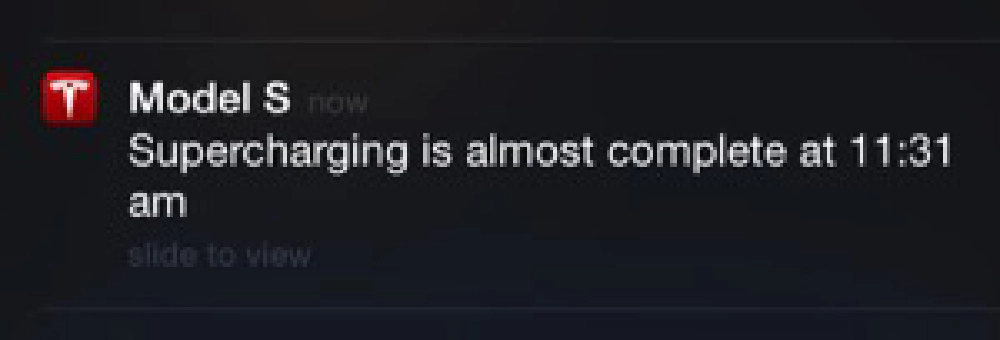
Tesla App Notification Charging Complete
To review, check out the differences in the options. The only one that isn’t totally accurate is the J1772 as it really varies between each charger. Thankfully apps like Plugshare let folks comment on the quality of the power generated:
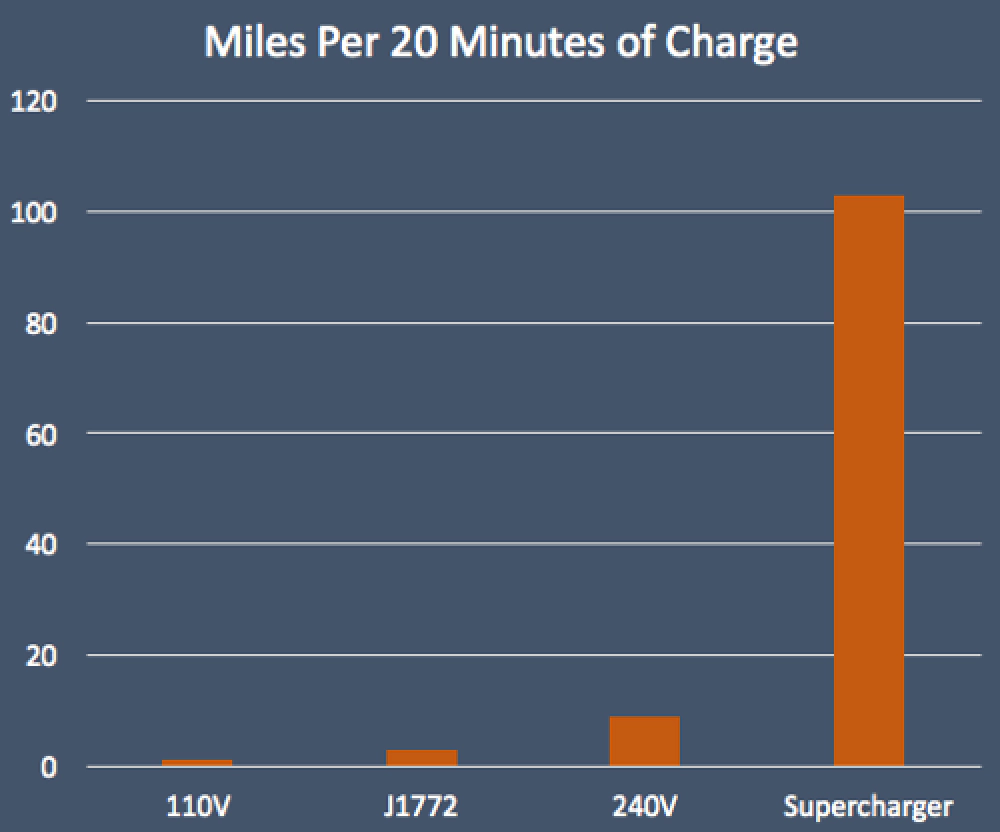
Tesla Chart
Destination Charging
Destination Charging is a new option. Tesla now shares the locations of venues like hotels or restaurants that have Tesla wall chargers.
Finding Charging Spots
A common question that comes up is the availability of charging options for electric cars. There are many, MANY more options that you’d expect. Two apps, PlugShare lists known charge points where others share ratings, share pictures and you can see any costs associated with them. Another, Chargepoint lets you set up an account so you can easily pay for some of the fee-based charging options. We did this recently at the Charlotte, NC airport. You can see how may options there are… for instance around where I live in Jacksonville, FL:
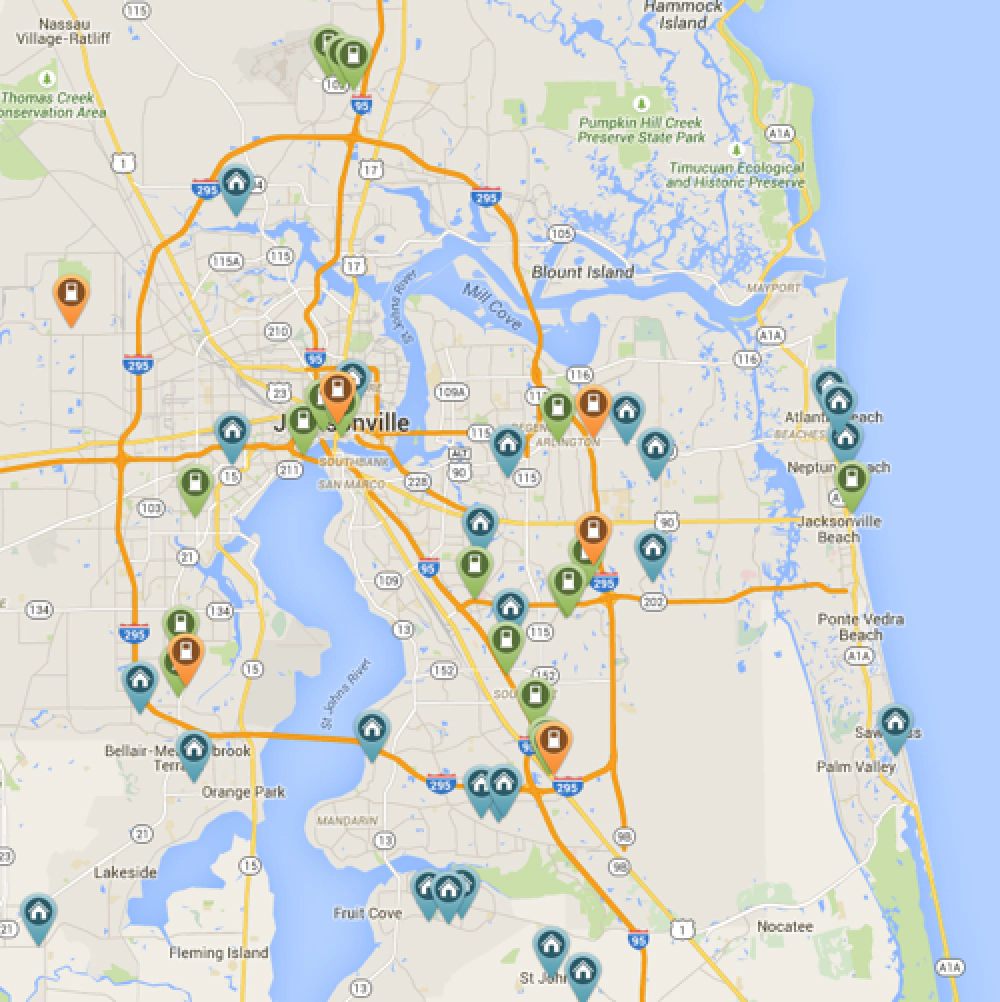
Plugshare App
The orange pins are high capacity chargers like a super charger. Green are public stations & blue are residential chargers. Yes, people have offered to help you out if you need a charge. Oh, that map above already has filtered out the chargers that are reported in use and not available.
But in reality, the only time you really worry about charging is when you are on a road trip or traveling. Around town, it’s never an issue. Each day you start with a “full tank” and in the two months we’ve had it, with daily usage, we’ve never drained the battery.
Companion Smartphone App
There’s a Tesla app for your phone (Android & iPhone… sorry you 18 Windows Phone users). You can use this to see the current status of the car (speed, power usage, location on a map, charge level and estimated mileage range remaining). You can also lock / unlock it, honk the horn, flash the lights, turn on the heat / air conditioning as well as start the car for someone who might have forgotten their keys. The app also connects to your calendar & contacts to push these details to the calendar & contacts apps on the car as well.
Traffic Aware Cruise Control (TACC)
ZOMG, I can’t express how cool this is. I know other cars have it & I have no frame of reference for the as I’ve only experienced TACC on the Model S, but it’s insane. OK, think normal cruise control… it works just like that, but better.
Refer to the picture below that I took while driving last week (sorry it’s not a better quality… I was driving and that was the priority). The car is outfitted with a radar device mounted low on the front of the car. If it detects a car in front of you, it maintains a radar lock on that car, indicated with the blue cruise batch above your speed. If it’s just normal cruise control, it’s a grey badge. Even if the car in front of me is going slower than I have cruise control set for, the car will maintain it’s distance with the brake & accelerator as the car in from of me speeds up or slows down. It even will come to a complete stop - this is absolutely awesome in stop & go traffic on the highway! There’s a little dial that lets you adjust how much distance it should maintain from the car in front of you.

Traffic Aware Cruise Control
Also shown in the picture on the left-side of the speedometer is the current cruise speed setting. The blue bar going up that left side is your current speed (61mph in my case… you can see how the car’s camera detected a 55mph speed limit sign and is warning me that i’m speeding… whoops). Just above the top of the blue line you can see a little gray arrow.. that is my current cruise control speed. So while I’ve set my cruise control to something around 70 in this case (that’s my guess form the picture), TACC has matched the speed of the car in front of me that’s going slower than my desired speed.
This takes so much of the boring part of road trips out of the equation. You still have to pay attention of course, but it really makes the drive a bit easier.
Our First 1,200+ Mile, 3-Leg Road Trip in the Model S
One of the biggest questions… ok it was more about apprehensions… was taking it on a road trip. This was something I wanted to talk to someone about before we placed our order so hoping this helps someone else!
In the last 10 days we traveled about 1,400 miles in a three-leg trek. The first stop was at a beach house we were renting with my wife’s parents, sister and brother’s families. After a week, we then had to take my son to camp in the mountains of North Carolina. We went from the beach to Charlotte, NC where we rented a SUV as his camp is deep in the mountains up a narrow & rough dirt road (i.e.: one we couldn’t take the Model S on). After taking him to camp, we headed back to Charlotte, NC (2hrs from camp) where we spent the night and then the following day headed home back home.
Florida » Beach » Charlotte
Charlotte » Florida
First, it’s amazing how much stuff you can fit in this car. The cargo space is huge… amazing how much space you get when there’s no engine, transmission, radiator… none of the components a combustion car has. Inside is roomy. The trunk has a cargo space under the floor (which is actually a footwell if you get the optional rear-facing 3rd row of seats). The picture below isn’t showing two more rows of bags behind my camera bag, work backpack & the orange duffle bag. It’s also nice having a front trunk, the “frunk”, which is holding a bunch of stuff (two yoga mats, two pillows, towels and our telescope).
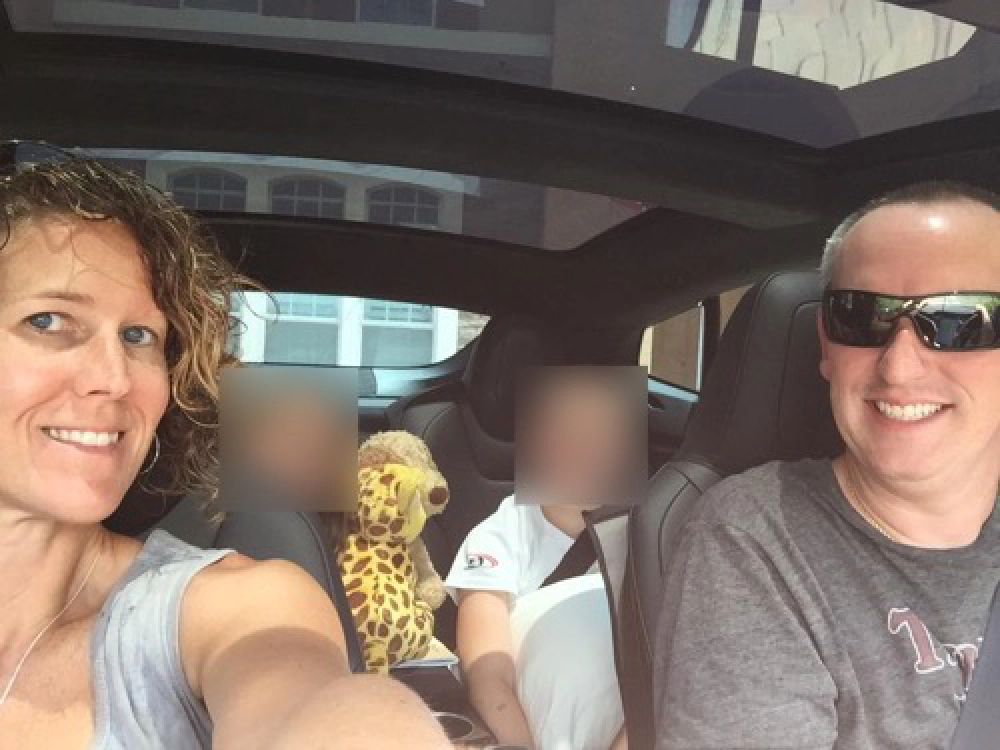
Roadtrip in a Tesla
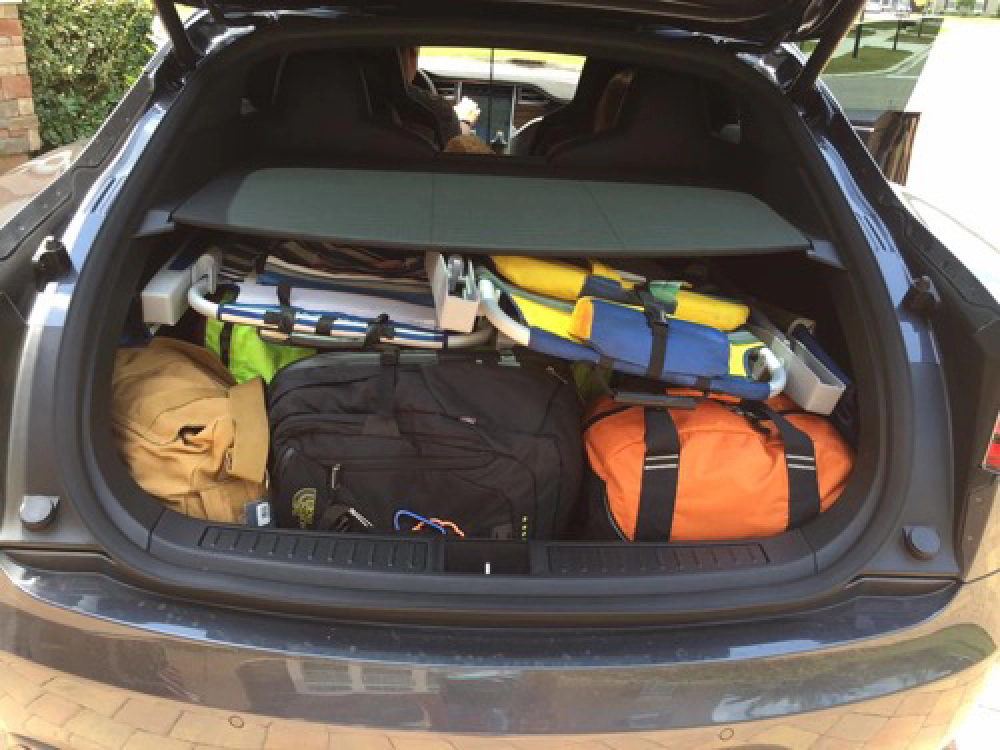
Roadtrip in a Tesla
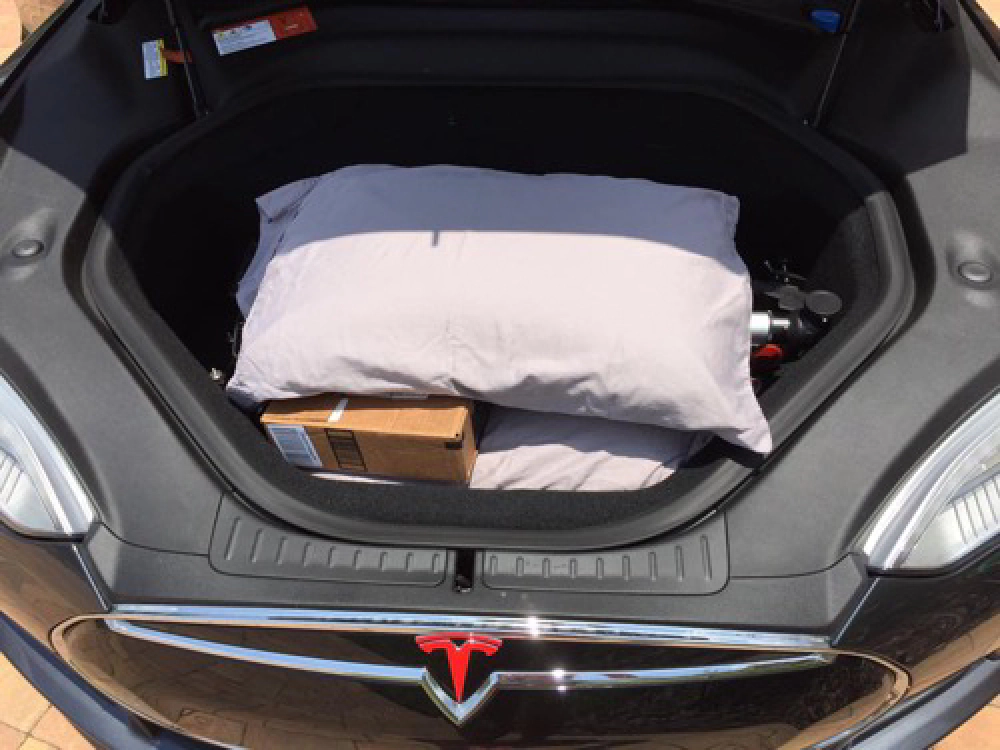
Roadtrip in a Tesla
Now, I thought it would be stressful and challenging to make sure we could charge up. I am not worried about getting stranded… you can easily find places to charge using an app like Plugshare. My wife made the comment that it sort of turns it into the gamification of road tripping. You can laugh, but it was actually an interesting challenge that we enjoyed. We’ll see if that wears off in due time though!
First Leg: St Johns, FL => Oak Island, NC (610 miles)
The first part of the trip was from home to the beach house, a 610 mile journey. When you plug in your destination, the car’s navigation helps you find superchargers along the way and suggests how long you should stay there to recharge to make it to your destination. With two kids under 10 years old, that duration for the trip wasn’t too far off what we usually get when we do our annual trip to the North Carolina mountains.
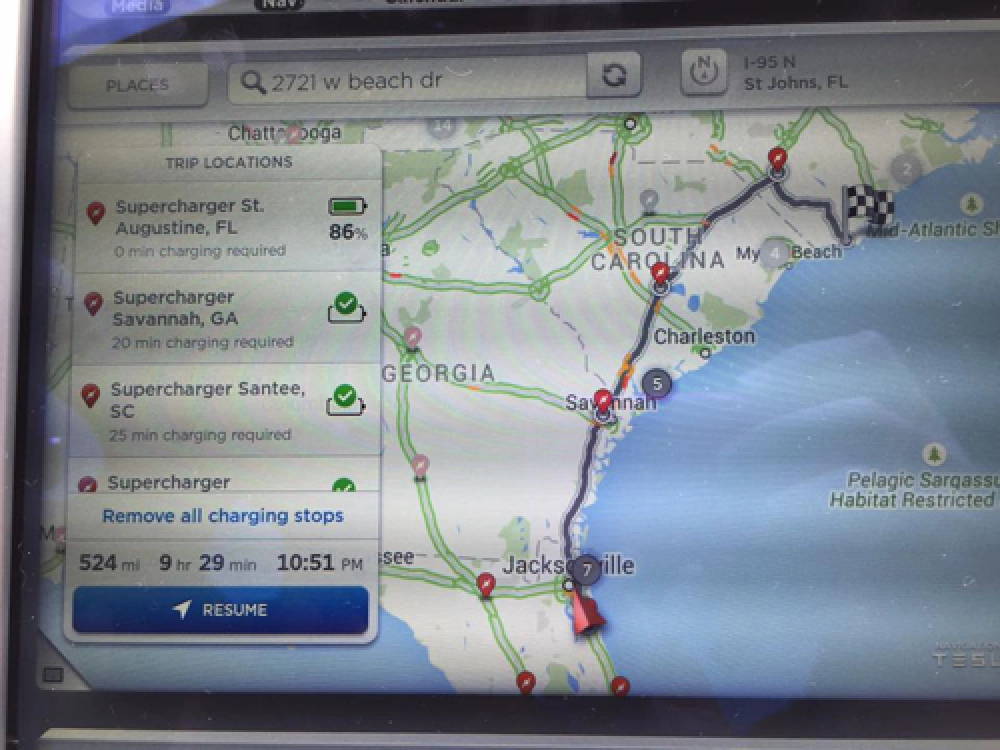
Navigation Map
Our first stop was at the Savannah, GE supercharger which is located in the economy parking for the Savannah airport:

Tesla Supercharger in Savannah, Georgia
It was at this stop that we quickly realized you want to pay attention where you plug in. Supercharger ports (the white tower looking things) are arranged in pairs like 1A, 1B, 2A, 2B, etc. Each pair of ports are powered by a single power unit so if another car is plugged into 1A, if you plug into 1B, you just cut his power draw by 50% and you’re only getting 50% of the potential. Once we figured this out & moved over one spot, we were pumping a solid 379 volts at 204 amps giving us about 309 miles of range per hour of charge. We stayed here for about 25 minutes which was just enough time to head into the terminal for a restroom break.
No need to worry about someone unplugging us; when the car is locked, the Model S locks the power cable into the car so you can’t remove it without unlocking the car. Best part was that when it was almost done getting the level of charge it needed to get to the next supercharger, it said so via a notification on my phone:

Notification Charging Almost Complete
Here we picked up 165 miles of range in 25 minutes. Airport parking cost us $1… so that $1 got us 165 miles… a lot better than what my SUV’s 18 miles/gallon rating would have cost us at the pump ($30).
Next we stopped in Santee, SC. This was near a Cracker Barrel where we ended up having dinner.
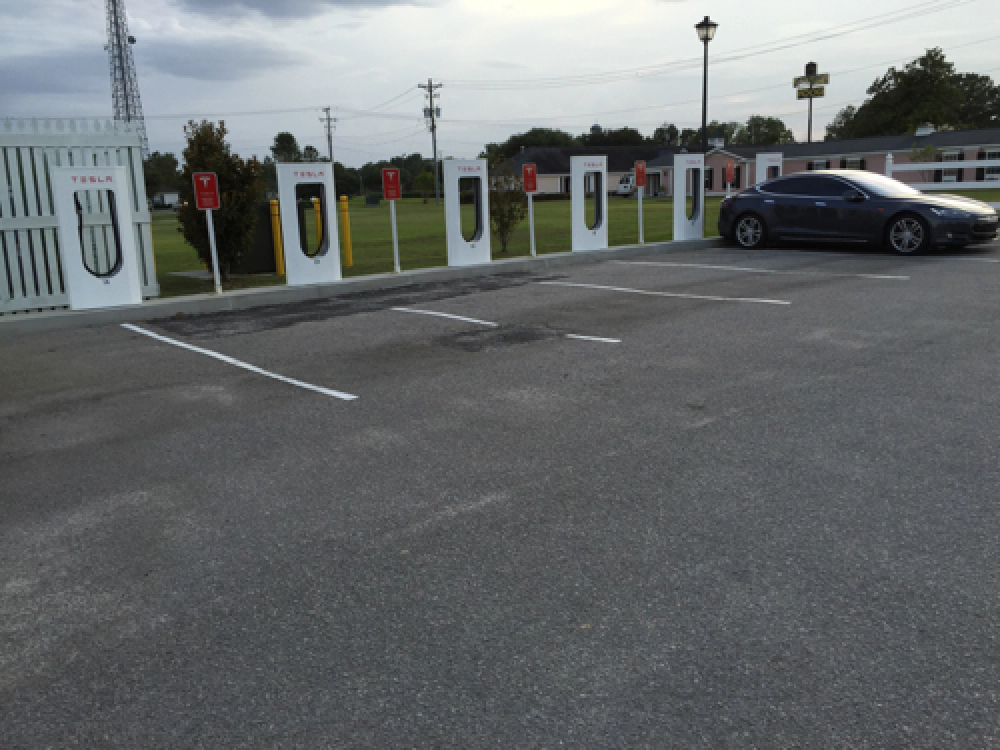
Tesla Supercharger in Santee, South Carolina
We walked out of there an hour later to a full 100% charge because we were there so long. Not bad!
Last we stopped in Lumberton, NC. Notice how crowded the superchargers are? We never had to wait for a spot at any of our stops.
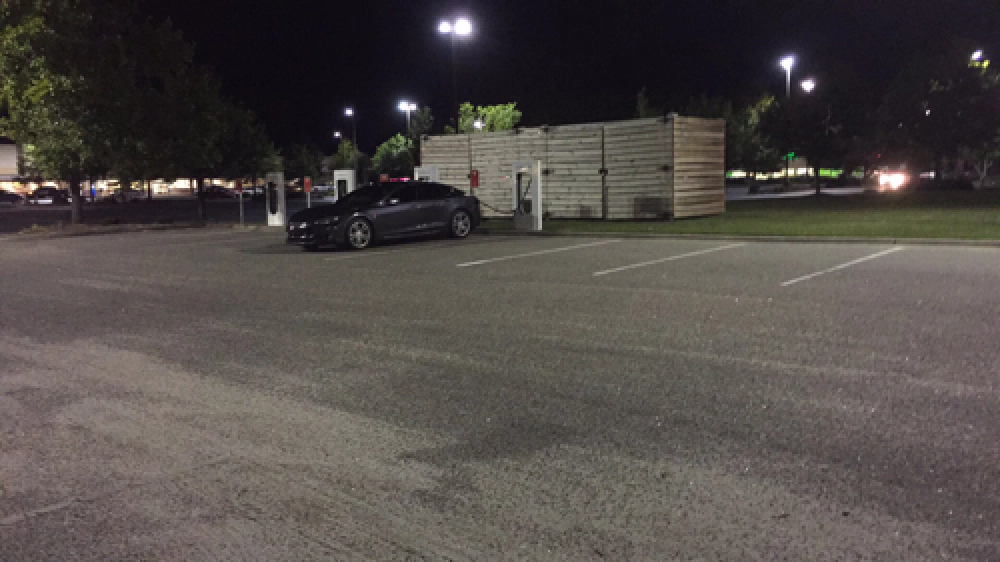
Tesla Supercharger in Lumberton, NC
We stayed here for a longer time as the drive to the beach house from here was 93 miles so that’s just shy of a 190 mile round trip. Frankly we wanted some buffer not knowing if we’d need our car when we got to the beach so we wanted to get it close to a 225 range before we left for the beach.
Once we got to the beach I pulled the mobile connector out, snapped on one of the 110V plugs under the house and let it start charging. We rolled in with 103 miles of range on Saturday night… took nearly 48hrs (around 11:30p Monday night) to get up to 244 miles (~90% charge).
Second & Third Leg: Oak Island, NC => Charlotte => St Johns, FL (775 miles)
About 24hrs before we left I set the car to charge up to 100% just in case, even though we only had a 216 mile trip. We stopped in Lumberton, NC again to get a 20 minute boost and headed over to Charlotte where we checked into our hotel. The next day we picked up a SUV rental car to take my son to camp which was about 110 miles away. We left the Model S at the airport where they had J1772 Level 2 plugs in hourly parking.

Airport Charger in Charlotte, NC
We left it plugged in from 8:54a to 3:59p charging at a rate of about 19 miles / hour of charge. It cost $14 for parking & a flat $5 to charge at the public charger, paid via the Chargepoint network. You sign up for Chargepoint through their website & they send you one of those RFID embedded frequent shopping cards you attach to your keychain. You use that to pay for the charge on your account. In those 7 hours, for $19, we picked up about 135 miles which we needed as we rolled in with 68 miles of range. This was enough to keep us from having to go to the Charlotte supercharger on the north side of the city adding at least an hour, likely more, to our drive home as 200 miles was enough to get back to the Santee, SC supercharger 170 miles away.
The trip home was just as uneventful. We stopped at the Santee, SC supercharger for lunch (the Model S got up to 90%, or 245 miles, before we were half-way through with our lunch even though we rolled in with just 22 miles to spare) and again at the Savannah, SC supercharger for 20 minutes to give us just enough to get home.
Conclusion
All in all, I’m more than pleased with the Model S. There’s nothing physical I’d change on the car. I do have some specific and nuanced wishes for the software like integrating Waze with the onboard navigation & the ability to find stuff on my phone and send it to the car’s navigation, or let me plan a trip on my phone and send it to the navigation rather than entering everything in on the screen.
As a car guy, the performance and handling of the car is unlike anything else I’ve driven. Thanks to the battery, the car is so heavy (4,600 pounds) that it feels like it is part of the road… I can take a corner at 60 mph like it was nothing. It’s quiet and incredibly comfortable for both city & highway driving.
As a tech guy, I love everything about it. They’ve nailed it… the only buttons on the dash are those required by law (hazard lights & glove box door opener)… everything else is on the screen. Updates to the OS happen over the air… either at home when connected to my WiFi or over the cellular network (the car comes with an included AT&T subscription that you don’t pay for monthly… it’s part of the car). I was a bit bummed when I found out that just 3 weeks before I took delivery of my car they started including LTE/4G modems in the car where mine had a 3G modem, but that’s life. Tesla doesn’t wait for a new year… when a new feature is ready, the add it to the car’s built at that time. If it really bothers me, I can either tether the Model S to my phone’s hotspot or I can take it in later this year and upgrade to a 4G modem (no word on the pricing). Right now, I can’t wait for the autopilot feature to get rolled into the OS… I’ve got the hardware on my car, just need the software!
Two thumbs up… zero regrets. Yes, it’s a significant investment (at least it was for our family), but I honestly feel like I got everything I paid for & it was worth saving up… a great value!